State Administration Building, Raleigh N.C.
Back in May we introduced a postcard miniseries featuring the seven state government buildings that encircle Capitol Square. This week’s Flashback Friday postcard is the second in that series — the State Administration Building, built in 1913. It is now known as the Ruffin Building, and houses the North Carolina Court of Appeals.
Long distance automobile travel must have been an arduous feat in the early days, as ‘Fred’ indicates in this message to ‘Mother’ in 1920.
Dec. 5, ’20
Dear Mother
Well we had a little bad luck today. We broke some ballberrings [sic] in the [illegible] wheel. But we got them fixed right away. We got as far as Rockingham, N.C. Tomorrow we will start out for Columbia, S.C. We are all well, and seen a lot of the world all ready. We put near fargot [sic]Â the day in the week.
(from Fred)
In my own experience, an extended road trip can certainly induce a sense of ‘lost’ time — I wonder where in the world Fred et al. were headed, and if they even finally got there!
An Early 20th Century Architectural Masterpiece
The ‘State Administration Building’ was designed by the talented Atlanta architect P. Thornton Marye. It was built in 1913 to house the NC State Supreme Court, Court Law Library, State Library, the North Carolina Historical Commission, and state administrative offices.
The architectural style blends Beaux-Arts Classicism with Second Renaissance Revival features. The building is of reinforced-steel poured concrete and masonry construction, and is faced with Indiana limestone with granite trim. Frank B. Simpson of Raleigh served as the onsite supervising architect.
Above is the new Administration Building as it appeared in 1914. The elegant courtroom occupied the space behind the tall windows seen here on the third floor. Below is a section of granite detailing at street level.
Marye made several contributions to Raleigh’s architectural integrity of the early 20th century. He also designed Raleigh’s City Hall and Auditorium (1910), Commercial National Bank (1912), and Wake County Courthouse (1915), all of which are now, sadly, lost.
A bronze statue of former Chief Justice Thomas Ruffin (served 1833-1852) was commissioned by the state legislature and placed in a niche in the Morgan Street entry loggia in 1915. It was designed by New York sculptor Francis H. Packer, who had also designed the statue of Spanish American War hero Worth Bagley, erected on Capitol Square in 1907.
Thomas Ruffin, NC State Supreme Court Chief Justice, 1833-1852.
In 1940 the NC State Supreme Court moved to the new Justice Building, located across Fayetteville Street from its former quarters. The former State Administration Building was later renamed the Ruffin Building.
The State Court of Appeals, North Carolina’s second highest court remained behind in the old building. During the late 1940s and early 1950s, the State Art Society, precursor to the North Carolina Museum of Art, used the vast interior spaces as an exhibition hall.
An exhibit of Barden photographs and Currier and Ives prints share space in the Ruffin Building in 1949.
An Extensive Renovation and Restoration
Following decades of make-shift alterations and benign neglect, the building underwent an extensive 18-month renovation in 2008 and 2009. Chief Justice John C. Martin noted that the “goal from the beginning was to marry the historical attributes of this beautiful old building with the efficiency and utility of a modern office building.”
Improvements included the modernization of offices with telecommunication and internet connections, installation of energy-efficient heating and cooling systems, ADA accommodations and the installation of elevators.
Although Mayre’s original monumental staircase was removed, it was replaced with a new grand staircase, illuminated by a skylight four stories above the lobby level.
An aesthetic highlight of the renovation was a meticulous restoration of the original third floor courtroom. The plaster ceiling was restored by a specialty subcontractor of international renown, whose experience included restoration work at Buckingham Palace.
The Ruffin Building was rededicated in January 2010.
The photo below shows the beautifully restored third floor courtroom.
Seen in the photos below are details of the intricate workmanship of the courtroom’s painted plaster ceilings.
(Courtroom photos by Raleigh Boy)
The Ruffin Building is open to the public for tours when court is not in session. If you are interested in seeing the restored courtroom and learning more about the building’s renovation, contact Court Marshall Dick Ellis at 919.831.3601 dee@coa.state.nc.us
This photo shows the new Administrative Building in 1914. I wonder if any GNR readers can identify the stonework construction on Capitol Square seen in the foreground.
Our Flashback Friday ‘white border’ postcard this week was published by long-time Raleigh stationer James E. Thiem Sr., and was printed by the Curt Teich C. of Chicago under the trade name ‘C.T. American Art Colored.’
Curt Teich Co.  1893-1974 Chicago, IL
A major publisher and printer. Their U.S. factories turned out more cards in quantity than any other printer. They published a wide range of national view-cards of America and Canada. Many consider them one of the finest producers of White Border Cards. The Linen Type postcard came about through their innovations as they pioneered the use of offset lithography. They were purchased by Regensteiner Publishers in 1974 which continued to print cards at the Chicago plant until 1978.
“Flashback Friday†is a weekly feature of Goodnight, Raleigh! in which we showcase vintage postcards depicting our historic capital city. We hope you enjoy this week end treat!

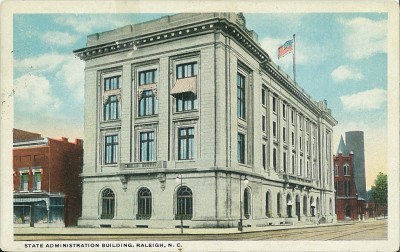
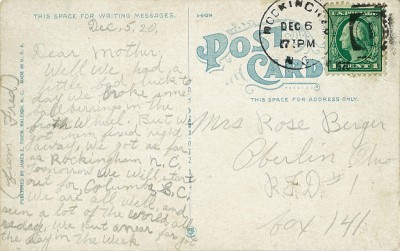
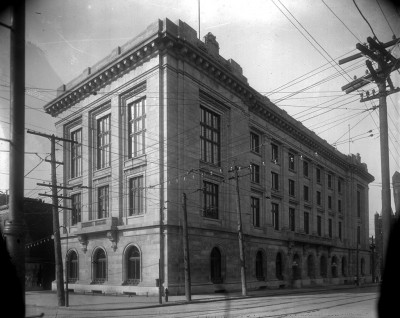

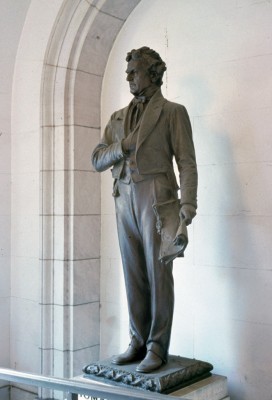
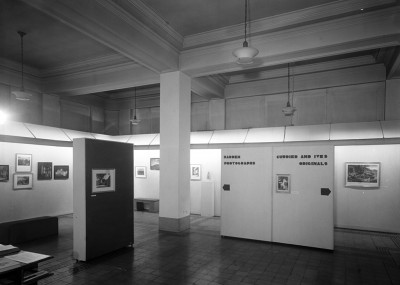
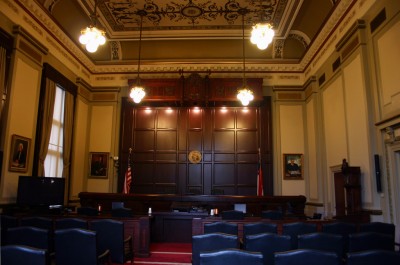

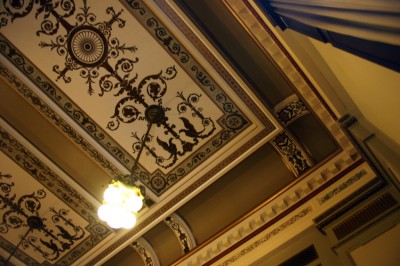
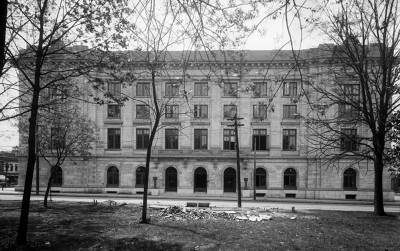
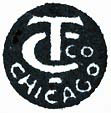
 Sign up for the Newsletter
Sign up for the Newsletter
07/05/2013
The construction in the forground is the placing of the “Women of the Confedercy” memorial. Ashley Horne of Clayton paid for it when the State of North Carolina refused to do so.It is a shame that most people who have no business in the Court of Apeals do not see the wonderful statue of Ruffin. Keep up the good work!
07/08/2013
I think Fred was trying to write that they “p’ret’ near forgot,” which can be translated “pretty near forgot.”
I know J. C. and lots of others who read this blog have heard someone use “p’ret’ near” (pronounced “purt near”) for “pretty near.”
Love my North Carolina/Wake County brogue!
07/09/2013
Mr. Knowles is correct. The last photo shows site preparation for the erection of the Women of the Confederacy Monument. It was funded by a $10,000 gift from Ashley Horne in 1911. The sculptor was Henry Augustus Lukeman. He collaborated with architect Henry Bacon, who designed the monument. Bacon is best known for his monumental design of the Lincoln Memorial in Washington, DC. The women of the Confederacy Monument was dedicated on June 10, 1914.
You can read the full details about the monument and its construction on the NC Commemorative Landscape website:
http://docsouth.unc.edu/commland/monument/99/
This early postcard in the North Carolina Collection depicts the monument:
http://dc.lib.unc.edu/cdm/singleitem/collection/nc_post/id/4511/rec/2
For any readers who are curious, I have added a photo of the statue of Chief Justice Thomas Ruffin to this post (above).
02/23/2020
I’ve written about the creation and placement of the statue of Thomas Ruffin here, https://docsouth.unc.edu/commland/features/essays/greene/ and in a longer article here https://muse.jhu.edu/article/447966
In the Southern Cultures article I discuss the fairly brief period of time in which the Court of Appeals building was called the Ruffin Building–which it no longer is. It’s an interesting story that involves a bit of politics between the two appellate courts.
The Ruffin statue is made of bronze because originally it was intended to go outside, on Union Square. The preferred spot would have been facing the court building, but Col. Horne had already claimed that spot for the monument to the Women of the Confederacy, whose foundation you can see in the 1914 photo, as noted above.
02/23/2020
I have written about the Ruffin statue here,
https://docsouth.unc.edu/commland/features/essays/greene/
and in a longer essay in Southern Cultures,
https://muse.jhu.edu/article/447966
As I explain in the Southern Cultures article, the COA building was only called the Ruffin Building (officially) for a few years, and that name came about as a result of some interesting in-fighting between the two appellate courts.
The statue was originally intended to go outdoors, on Union Square; that’s why it was made of bronze. The intent was to have it face the court building–but that spot was preempted by Col. Horne and his monument to the Women of the Confederacy, whose location is noted above.